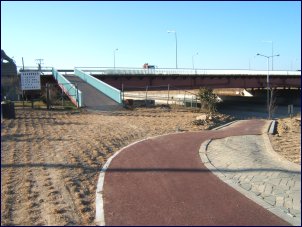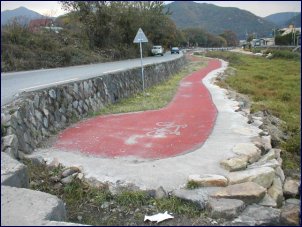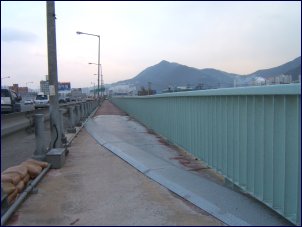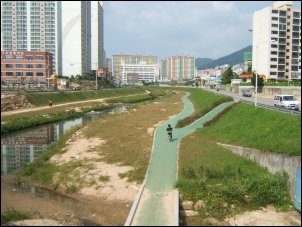
Observations on the Infrastructure for Bicycle Travel
![]()
BACK
to index page Bicycling in Korea

Introduction
On this page I would like to summarize ideas that I have collected in discussions with bicycle friends about bicycle lanes and other measures to control bicycling on Korean roads. Many ideas for improvements also came up during the many bike tours I made in this country. On this page I have expressed my opinions and suggestions, hoping that they will be used by the biking community and responsible authorities as a source for further discussions and, who knows, may eventually contribute to a better Korea for cyclists.

1. Make bridges better accessible for cyclistsEspecially outside Seoul, there are not many major bridges that have a bicycle lane. And if there is a bicycle lane, the access is in many cases very poor. Where cars climb onto a bridge with a gentle 3% slope, the cyclist in many cases has to carry his bike up stairs, or push it up a steep ramp, as in the photograph on the right (Nakdong River Main Bridge, Busan). Also notice the careless finishing work at the bottom end of the ramp.On the other side, the connection between the bikepath and the bridge access seems to be forgotten. | 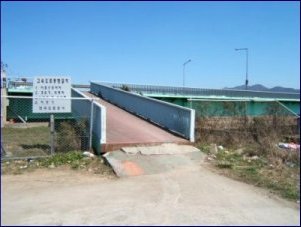
|
2. Replace the 'cateyes' by a type that does not demolish bike tyresReflectors that are built in the roads surface on the sides and sometimes in the middle ('cateyes') are a real danger for cyclists because of their design. Thay have sharp metal edges and the square design punches holes in tubes of bicycle tyres that are smaller than a standard ATB tyre. For racing bikes, like my own bike, riding over such a cateye is almost a guarantee for at least a flat tyre. | 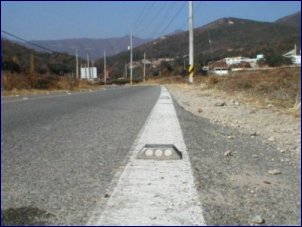
|
3. Let the traffic police clean up the rubbish from a car accidentCar accidents not only leave traces in the form of painted marks on the road, but also by the broken glass and other debris, that is in general not removed and becomes a hazard for (especially) cyclists. This idea is not new: I wish a delegation of the Korean Traffic Police would make a working visit to Singapore and take a lesson from their Singaporean colleagues. | 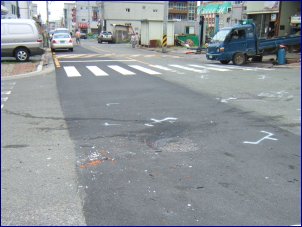
|
4. Make elevated bikepaths, if separated from the main roadWhen the bikepath is at the same level as the main road, litter from the road is easily washed or swept on to the bikepath. If the bikepath is separated from the main road, as in the photograph (between Gisang and Songjeong, Busan City), there is little chance that it is ever cleaned. Litter on main roads is removed automatically by car tyres over a period of time. Also main roads can be cleaned easier. In this case: Raise the level of the bike path, let the rubbish stay where it comes from. | 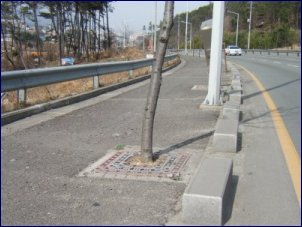
|
5. Make the bikelane part of the main roadIn my opinion, this is the best solution, for inside as well as outside urban areas. The smoothness of the surface should be not less than on the main road. The shoulder, if any, should be on the right side of the bike lane; wide enough (not on this picture, taken on road no. 2 between Masan and Jinhae) for emergency stops for cars.The 'cateyes' give sufficient clear separation between motorized- and bicycle traffic, but it provides the needed 'openness' of the bikelane, preventing it for being used as a storage area or rubbish dump. This open situation also stimulates that the wind from big passing-by vehicles automatically cleans the bikelane, contrary to the situation shown above. | 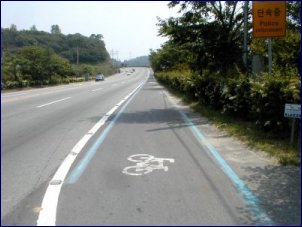
|
6. Abandon all bikelanes on sidewalksThe picture on the right (Busan City) looks like a humoristic snapshot, but it is a very common situation. Bicycles are supposed to use the red coloured lane right next to the buildings. What about people that leave the shops? Fortunately accidents rarely occur, because no cyclist is crazy enough to try to stay in this lane. It's the authorities that make themselves ridiculous by spending so much on creating more danger. No need to spend more money to remove them: nobody notices these lanes anyway. | 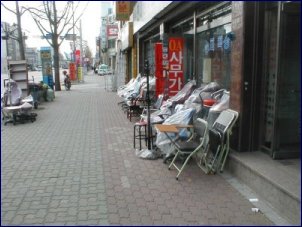
|
7. Don't treat cyclists like wheeled pedestriansKorea needs bikepaths where you can freely ride a bicycle, without interruptions like on this photograph. It's a matter of taking the bicycle serious as a means of transport. Look also at the bad surface of this path.I wonder what the Public Works department officials had in mind when they designed this bikepath (bottom photograph) | 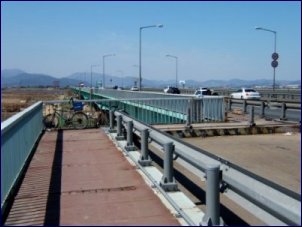
|
8. Remove obstacles that cross the bikelane under a small angleFor a four-wheeled vehicle this obstacle is no problem, but for two-wheeled bicycles this causes a real danger. The wheel follows the edge of the obstacle instead of crossing it and a fall is eminent, if no precaution is taken. It is the same problem that arises with railway tracks that do not cross the bikepath perpendicularly.Aparently the problem shown on the photograph above right was acknowledged. But the repair of the hazard caused an even much more dangerous situation, by making a "bridge" from steel plates. It's very slippery and the same problem still exists!. It would be good to get first a cyclist's advise before "improving" a bike path. | 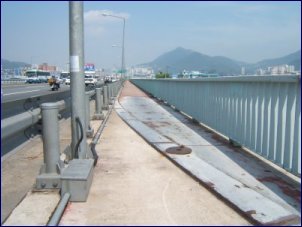
|
9. Cover steel plates used as road surfaceAt construction projects that take place (partly) under roads, such as the construction of subways, steel plates are used as a temporary road surface. When wet, these plates become very slippery and are extremely dangerous for cyclists. At least on the right side of the road where bicycles ride, these steel plates should be coated with a material that let the bicycle wheel keep a grip on the road. | 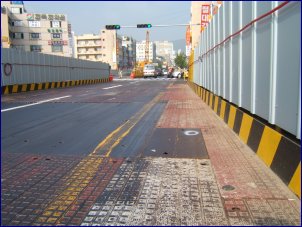
|
10. Place drain grates so that they don't trap the bike tyreDrain grates in the road always have holes to let the water drain into the sewerage system. These holes have a long and narrow shape, but these holes can be wider than your bike tyre. If the long side of the hole is in the direction of the traffic flow, as in the photograph (Busan, Jurye subway station), it causes a great danger for bicycles. In fact the drain grates are square, so care should be taken that they are always placed in the way that the length of the hole is perpendicular to the traffic direction. | 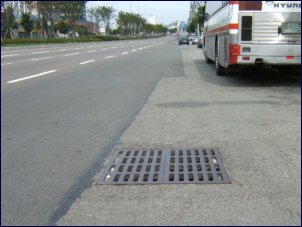
|
11. Avoid bike unfriendly expansion joints at bridgesJust before I took the picture to the right (Busan, Suyeong Bridge no. 2), this evil grinning monster devoured one tyre and two inner tubes of my racing bike. These holes are wide enough for normal bike tyres to get trapped too. At this place, the (too narrow) bike / pedestrian lane was blocked by a compressor that was left there. The message here is "Think of the bicycles when creating or altering traffic situations!" | 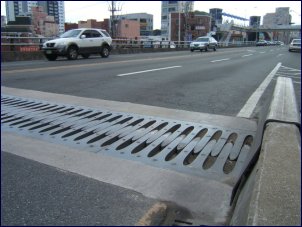
|
12. Maintain Bikepathsno comment.... | 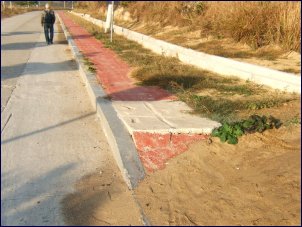
|
13. Leave space for motorists to pass by bicyclesHere there is no room for a bicycle and a car together and the plastic poles create a very dangerous situation. Immediate removal is required! They should only be used if a bikepath or a separate bikelane is present. | 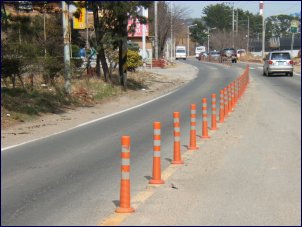
|
14. Use existing foundations for bikepathsA fairly cheap way for excellent bicycling promotion is using existing river dikes and abandonned railway tracks for constructing exclusive bikepaths. Both have already a minimum of interference with normal roads, a well compacted foundation and have very gentle gradients. (photo: Busan Seo-gu along Nakdong River)Another very suitable place for constructing bikepaths are riverbanks, a concept widely adopted in Europe and happily also in various places in Korea, like along the Han River in Seoul and here in Gimhae City. | 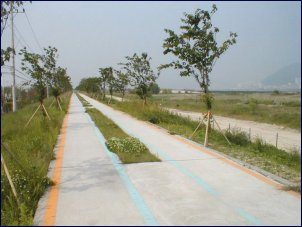
|
15. Abandon the use of aggregate for parking placesEspecially in front of restaurants, but also a temporary road pavement, often coarse aggregate is used. The car tyres 'catch' the stones and take it to the main road. it is extremely dangerous for cyclists and the use of aggregate as pavement should be abandonned. (photo: Road no. 19 near Muju, Jeolla bukdo) | 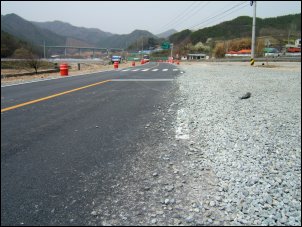
|
16. Let curbstones sink to the level of the streetThis is not a typical Korean problem, but nevertheless it should be mentioned. It is the main reason that racing bikes cannot use bikelanes. (photo: Gwangyang, Jeolla namdo) | 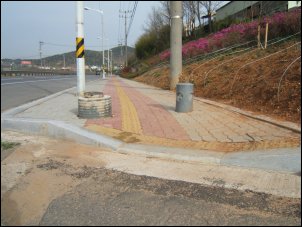
|
17. Give cyclists a smooth downhill rideThe stripes on the road are for slowing down motorists, very commonly used on steep descents. They are often made over the full width of the lane and are a burden for cyclists. On the right side, some space should be left open so that cyclists don't need to take all those hurdles. (photo: Gimhae City, Gyeongsang namdo) | 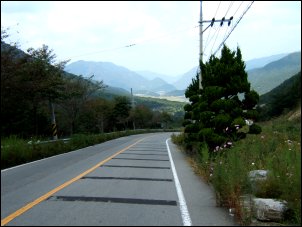
|
18. Don't make confusing rules for cyclistsThis note on a bike lane in Busan City reads: "ride on the left side". If you start learning to ride a bicycle here, how will you behave on roads where also other traffic is? What's the use of riding left here and is Korea ever going to take bicycle transport serious? | 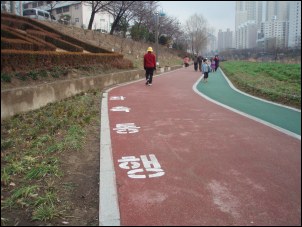
|

BACK to index page Bicycling in Korea
![]()
